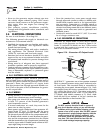
30 Generac
®
Power Systems, Inc.
• Never tee the generator engine exhaust pipe into
the vehicle engine exhaust piping. This causes
excessive back pressure on the generator engine.
Also, water from one engine can damage the
other engine.
• Plan exhaust system installation carefully.
Comply with all applicable codes, standards, and
regulations.
2.6 ELECTRICAL CONNECTIONS
Be sure to read Section 1.6 on Page 20.
The following general rules apply to electrical con-
nections in a recreational vehicle:
• Qualified electricians who are familiar with applic-
able codes, standards, and regulations should
install electrical wiring.
• The wiring should comply with codes, standards,
and regulations. The National Electrical Code
(NFPA 70), and state and local codes apply.
• Switches and circuit breakers should be of a type
approved for use in recreational vehicles and must
be mounted and installed to prevent damage from
road shock.
• Wiring must be of adequate size, have approved
insulative qualities, and be properly supported.
• Conduit and wire openings into the generator com-
partment (if used) must be vapor-sealed to prevent
entry of flammable, explosive, or poisonous gases
into the vehicle.
2.6.1 ELECTRICAL JUNCTION BOX
Install an approved, square electrical junction box
with a blank cover on the interior or exterior wall of
the area you plan to install the generator (NOT on the
generator). Route the generator's AC output leads
into this junction box through approved flexible con-
duit. This is the point of first termination for genera-
tor AC output leads.
2.6.2 WIRING
• Wiring should be of stranded copper to reduce the
chance that vibration may cause breakage.
• Wire gauge size should be large enough to handle
at least 115 percent of the installed generator's
rated maximum current.
• If neutral conductors are used, they must be the
same size as other leg wires.
• Route power supply conductors from generator AC
output leads T1 (red), T3 (black), and the green
ground wire through approved flexible conduit to
the electrical junction box on the compartment wall.
If a flexible metal conduit is used between the gener-
ator and the compartment junction box, the conduit
end that terminates at the compartment junction box
must be vapor-sealed. Flexible metal conduit is NOT
vapor-tight along its entire length.
• From the junction box, route power supply wires
through approved conduit to either (a) double-pole,
double-throw transfer switch, or (b) approved isola-
tion receptacle. Connecting to a transfer switch or
isolation receptacle must prevent vehicle electrical
circuits from being connected to two different power
supplies at the same time (such as, generator and
dockside power).
• Conductors must be rated 221° F (105° C) or must
be of a larger conductor size.
2.6.3 GENERATOR AC CONNECTIONS
Generator AC output leads T1 (red), and T3 (black)
come out of the generator, as shown in Figure 2.14.
Leads T1 (red) and T3 (black) are “hot.” There is also
a green lead that connects to ground in the junction
box of the recreational vehicle.
Figure 2.14 – Generator AC Output Leads
QUIETPACT ™ generators use a four-position terminal
block to connect between stator power leads and vehi-
cle load leads. This terminal block is accessible by
removing the access panel, shown in Figure 2.14. Units
are shipped from the factory connected for (230 volts
AC) output (See Figure 2.15). The stator power wind-
ings are connected in series. Lead 11/11A connects to
T3 (Black), lead 44/44A connects to T1 (Red), while
leads 22 and 33 are isolated. A "tie bar" connects the
two switch handles on line breaker CB1.
Do NOT connect electrical loads in excess of
any circuit breaker rating, or you will develop
problems with circuit breaker tripping, which
causes a loss of AC output. Also, do NOT exceed
the generator’s rated wattage capacity. Add the
watts or amps of all lighting, appliance, tool,
and motor loads the generator will operate at
one time. This total should be less than the
unit’s rated wattage/amperage capacity.
T1 (Red)
T
3 (Black)
Ground
(Green)
◆
◆
◆
Section 2 – Installation
QUIETPACT™ 65D Recreational Vehicle Generator


















